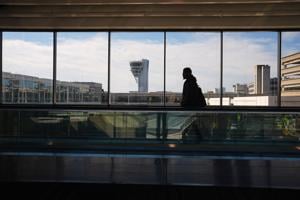
U.S. airlines are set to implement significant flight reductions at the country’s busiest airports starting Friday, impacting major travel hubs in cities such as New York, Los Angeles, Dallas, and Chicago. This decision comes as a direct result of the ongoing government shutdown, which has left air traffic controllers working without pay and led to increased absenteeism among staff. According to a list distributed to airlines and obtained by The Associated Press, the Federal Aviation Administration (FAA) has mandated a phased reduction of air traffic at 40 key airports across more than two dozen states.
The initial cuts will see a reduction of 4% of flights at these airports starting on Friday, with plans to increase the reduction to 10% in the coming days. United Airlines has confirmed that it will eliminate 4% of its scheduled flights over the weekend based on FAA guidance, as reported by company spokesperson Josh Freed. The FAA had not published an official order by midday Thursday and did not immediately respond to inquiries regarding implementation details.
Airlines are prioritizing cuts to routes connecting small and medium-sized cities, which could significantly disrupt travel plans for many passengers. Industry analyst Henry Harteveldt emphasized, “This is going to have a noticeable impact across the U.S. air transportation system.” With the busy holiday season approaching, travelers are already reconsidering their plans. For instance, Fallon Carter canceled her flight from New York to Tampa, Florida, expressing concern about her ability to return in time for a wedding.
Anticipated Disruptions and Safety Measures
The FAA announced on Wednesday that it would enforce a 10% reduction in air traffic across high-volume markets to ensure safety, as controllers have been showing signs of strain. The FAA’s decision follows an alarming trend of air traffic controllers experiencing increased absenteeism during the shutdown, which began on October 1, 2023. Many controllers are working mandatory overtime without pay, which has resulted in staffing shortages and delayed flights.
Passengers can expect notifications about cancellations to begin on Thursday, and airlines are making efforts to minimize the impact on customers. Major carriers, including Delta Air Lines and American Airlines, have stated they will offer refunds to travelers who choose not to fly, even for non-refundable tickets. Frontier Airlines has advised passengers to consider purchasing backup tickets with other airlines to avoid being stranded.
The disruptions also have implications beyond passenger travel. Key distribution centers for logistics companies like FedEx and UPS are located at affected airports, including those in Memphis, Tennessee, and Louisville, Kentucky. The cuts could potentially impact package deliveries, complicating logistics operations during an already challenging time.
Ongoing Challenges in Air Travel
The current government shutdown has introduced unprecedented challenges to the U.S. air travel system. U.S. Travel Association President and CEO Geoff Freeman noted, “The shutdown is putting unnecessary strain on the system and damaging confidence in the U.S. air travel experience.” Frequent traveler Kelly Matthews from Flat Rock, Michigan, has canceled most of her upcoming trips and understands the difficulties faced by federal employees who have been working without pay.
Recent weekends have seen some of the worst staffing shortages since the shutdown began, with at least 39 air traffic control facilities reporting potential staffing limits. This number is a significant increase compared to average weekend staffing levels prior to the shutdown.
The FAA’s approach to managing air traffic during this crisis is unprecedented. Administrator Bryan Bedford remarked, “I’m not aware in my 35-year history in the aviation market where we’ve had a situation where we’re taking these kinds of measures. We’re in new territory in terms of government shutdowns.”
As the situation evolves, both travelers and airline operators are bracing for the extended implications of these flight cuts, with safety and efficiency at the forefront of concerns as the aviation industry navigates this challenging landscape.







